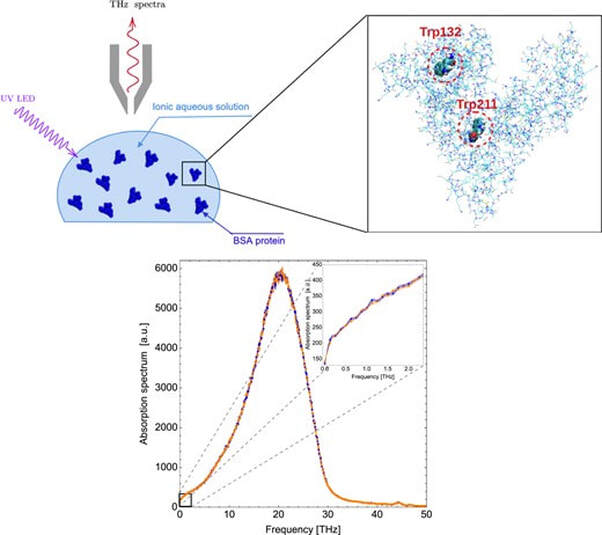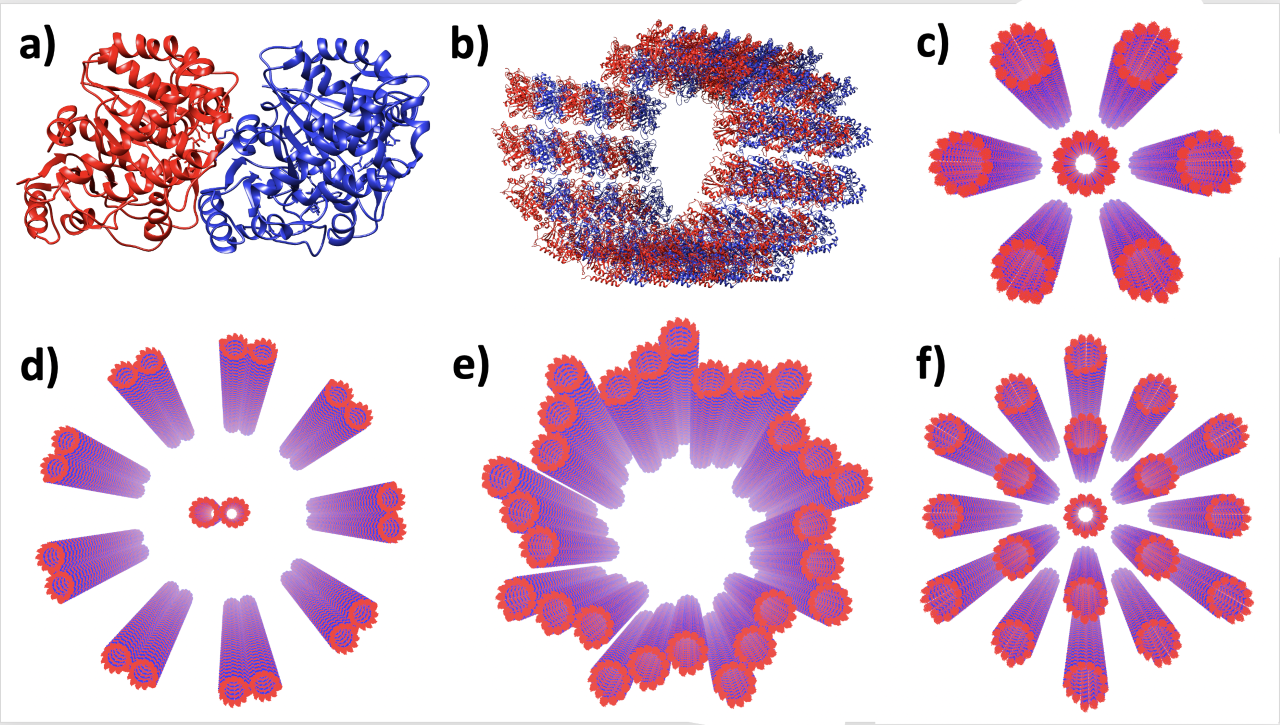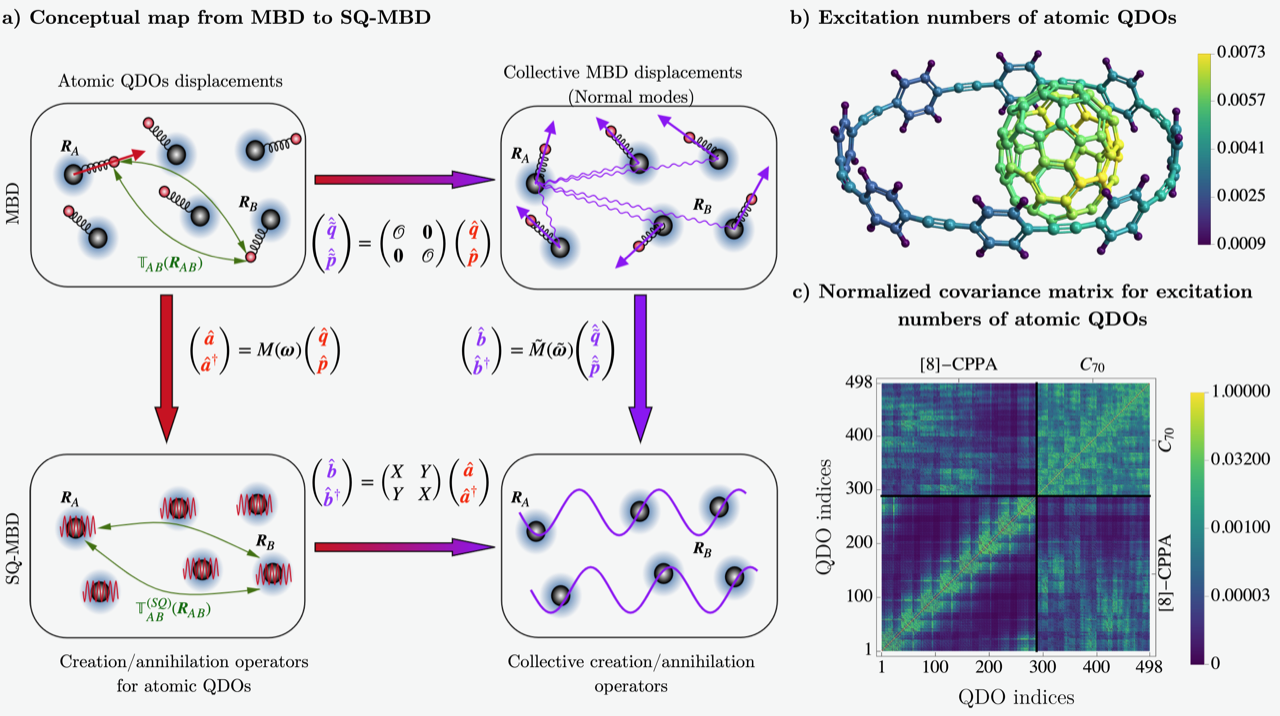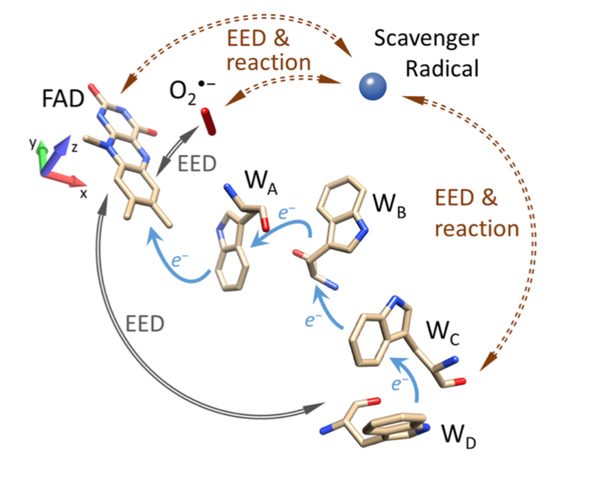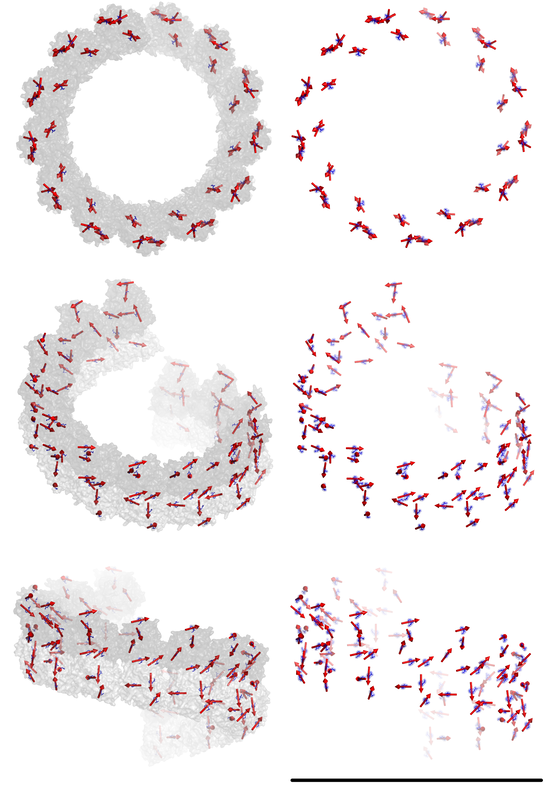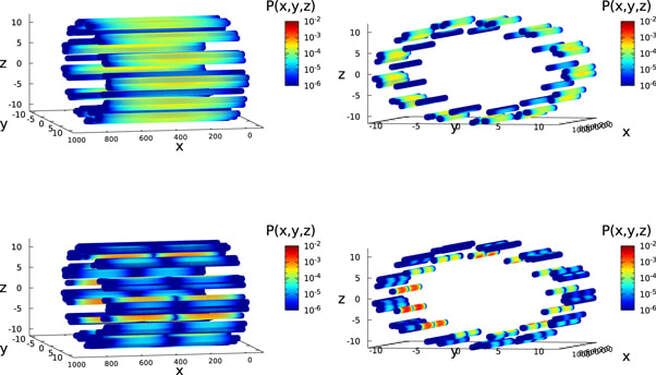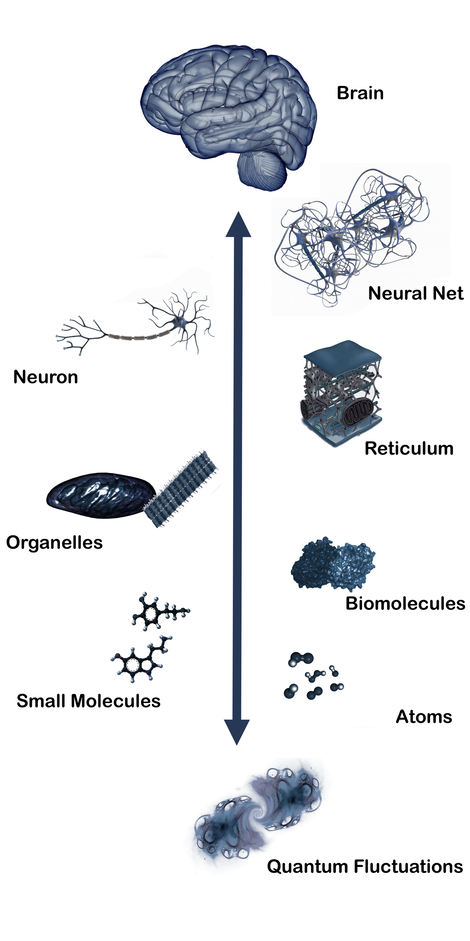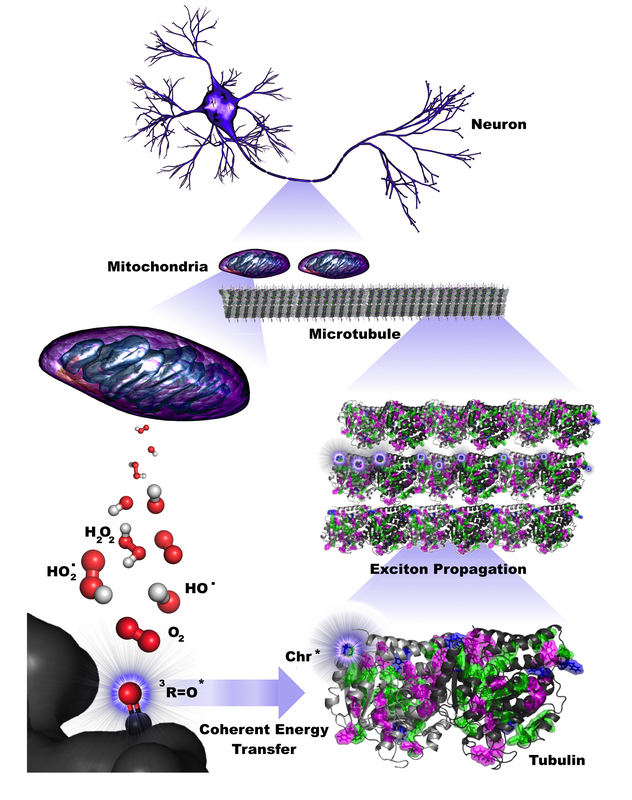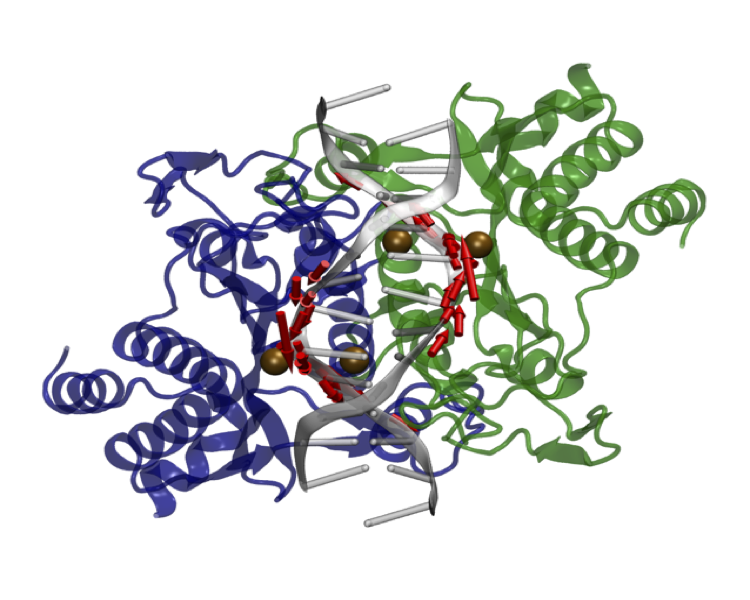Note: Copyright and all rights therein are retained by the author(s) and/or the Quantum Biology Laboratory (QBL). All persons copying this material, and/or content on this site, are expected to adhere to the terms and constraints invoked by each author's and the QBL’s copyrights.
2024
Ultraviolet Superradiance from Mega-Networks of Tryptophan in Biological Architectures
N Babcock, G Montes-Cabrera, K Oberhofer, M Chergui, G Celardo, P Kurian
The Journal of Physical Chemistry
N Babcock, G Montes-Cabrera, K Oberhofer, M Chergui, G Celardo, P Kurian
The Journal of Physical Chemistry
2023
Second quantization of many-body dispersion interactions for chemical and biological systems
M Gori, P Kurian, A Tkatchenko
Nature Communications
M Gori, P Kurian, A Tkatchenko
Nature Communications
Examining the origins of observed terahertz modes from an optically pumped atomistic model protein in aqueous solution
K Azizi, M Gori, U Morzan, A Hassanali, P Kurian
PNAS Nexus
K Azizi, M Gori, U Morzan, A Hassanali, P Kurian
PNAS Nexus
Left upper panel shows a schematic presentation of the experimental setup motivating our proof-of-concept atomistic simulations studying the terahertz spectra of an aqueous protein solution. Right upper panel shows zoomed-in atomic structure of the protein bovine serum albumin (BSA), with tryptophan residues highlighted. Water and ions are omitted for clarity. Bottom panel shows simulated absorption coefficient (in arbitrary units, a.u.) of the whole system vs. frequency for the BSA aqueous solution, with tryptophans in the ground state (blue) and the photoexcited state (orange). In the inset, the detail of the absorption spectrum of the protein-ions-water system is shown, highlighting the low-frequency range (0–2.35 THz).
Toward Quantum Machine Translation of Syntactically Distinct Languages
M Abbaszade, M Zomorodi, V Salari, P Kurian
M Abbaszade, M Zomorodi, V Salari, P Kurian
Ultraviolet superradiance from mega-networks of tryptophan in biological architectures
N Babcock, G Montes-Cabrera, K Oberhofer, M Chergui, G Celardo, P Kurian
N Babcock, G Montes-Cabrera, K Oberhofer, M Chergui, G Celardo, P Kurian
Hierarchical mega-networks of tryptophan form in protein architectures of functional biological significance. Panels depict a hierarchy of tubulin structures composed of 𝛼 and β tubulin (shown in blue and red), where panel a) shows an individual tubulin dimer containing eight tryptophans, b) shows a microtubule segment of three dimer-defined spirals, c) shows a hexagonal bundle of seven microtubules from a typical mammalian axon, d) shows a prototypical axoneme geometry found in ciliary structures, e) shows the characteristic vortex spiral arrangement of 27 microtubules in a eukaryotic centriole, and f) shows a hexagonal bundle of 19 microtubules from a typical mammalian axon. Panels a) and b) were generated with Chimera. Panels c), d), e), and f) were produced using Visual Molecular Dynamics on the Argonne Leadership Computing Facility mainframe.
2022
Examining the origins of observed terahertz modes from an optically pumped atomistic model protein in aqueous solution
K Azizi, M Gori, U Morzan, A Hassanali, P Kurian
Second Quantization Approach to Many-Body Dispersion Interactions
M Gori, P Kurian, A Tkatchenko
K Azizi, M Gori, U Morzan, A Hassanali, P Kurian
Second Quantization Approach to Many-Body Dispersion Interactions
M Gori, P Kurian, A Tkatchenko
Theory and practice of the second quantization approach to many-body dispersion (MBD) interactions in complex systems. Panel (a) shows a schematic representation of the commutative diagram establishing the mapping between systems of coupled atomic quantum harmonic oscillators and the second-quantized formalism (SQ-MBD). Panel (b) shows the mean excitation numbers of atomic quantum harmonic oscillators (so-called quantum Drude oscillators, or QDOs) in the ground state for the supramolecular complex of C_70 fullerene surrounded by a cycloparaphenyl ring composed of 8 units ([8]-CPPA). Panel (c) shows the normalized covariance matrix for excitation numbers of interacting atomic QDOs, decomposed into single Cartesian components.
Quantum Probes In Cancer Research
M Abbas, P Kurian
Nature Reviews Cancer
From Micro to Macro: A Relativistic Treatment of the Chiral Energy Shifts Caused by Static Electromagnetic Effects on Free Electrons
P Kurian
Entropy
Experimental evidence for long-distance electrodynamic intermolecular forces
M Lechelon, Y Meriguet, M Gori, S Ruffenach, I Nardecchia, E Floriani, et al.
Science Advances
A Chirality-Based Quantum Leap
C Aiello, J Abendroth, M Abbas, A Afanasev, S Agarwal, A Banerjee, et al.
ACS Nano
Are Brain–Computer Interfaces Feasible With Integrated Photonic Chips?
V Salari, S Rodrigues, E Saglamyurek, C Simon, D Oblak
Frontiers in Neuroscience
M Abbas, P Kurian
Nature Reviews Cancer
From Micro to Macro: A Relativistic Treatment of the Chiral Energy Shifts Caused by Static Electromagnetic Effects on Free Electrons
P Kurian
Entropy
Experimental evidence for long-distance electrodynamic intermolecular forces
M Lechelon, Y Meriguet, M Gori, S Ruffenach, I Nardecchia, E Floriani, et al.
Science Advances
A Chirality-Based Quantum Leap
C Aiello, J Abendroth, M Abbas, A Afanasev, S Agarwal, A Banerjee, et al.
ACS Nano
Are Brain–Computer Interfaces Feasible With Integrated Photonic Chips?
V Salari, S Rodrigues, E Saglamyurek, C Simon, D Oblak
Frontiers in Neuroscience
2021
Radical Scavenging Could Answer the Challenge Posed by Electron–Electron Dipolar Interactions in the Cryptochrome Compass Model
N Babcock, D Kattnig
Open Access Journal of the American Chemical Society (JACS Au)
N Babcock, D Kattnig
Open Access Journal of the American Chemical Society (JACS Au)
Enlarged representation of the pertinent electron transfer pathway constituted by the tryptophan tetrad, the cryptochrome cofactor flavin adenine dinucleotide (FAD), and relevant radical sites. Both photoreduction and reoxidation pathways, with electron-electron dipolar (EED) interactions, are shown simultaneously, although they correspond to different stages of the reaction cycle.
Mass Transport through Nano-Structured Membranes
K Azizi
Ph.D. Thesis
Application of quantum natural language processing for language translation
M Abbaszade, V Salari, S Mousavi, M Zomorodi, X Zhou
Institute of Electrical and Electronics Engineers (IEEE) Access
Theory of four-wave mixing for biomolecular systems: Toward transduction of quantum information from fluorescent protein complexes to photonic readouts
M Gori, G Gul, P Kumar, P Kurian
Bulletin of the American Physical Society
van der Waals Forces in Biomolecular Systems: from Solvation to Long-range Interaction Mechanisms
M Stöhr, M Gori, P Kurian, A Tkatchenko
Bulletin of the American Physical Society
Second Quantization of Many-Body Dispersion Formalism: Towards Efficient Quantum Modeling of Million-Atom Systems in Complex Environments
M Gori, A Tkatchenko, P Kurian
Bulletin of the American Physical Society
K Azizi
Ph.D. Thesis
Application of quantum natural language processing for language translation
M Abbaszade, V Salari, S Mousavi, M Zomorodi, X Zhou
Institute of Electrical and Electronics Engineers (IEEE) Access
Theory of four-wave mixing for biomolecular systems: Toward transduction of quantum information from fluorescent protein complexes to photonic readouts
M Gori, G Gul, P Kumar, P Kurian
Bulletin of the American Physical Society
van der Waals Forces in Biomolecular Systems: from Solvation to Long-range Interaction Mechanisms
M Stöhr, M Gori, P Kurian, A Tkatchenko
Bulletin of the American Physical Society
Second Quantization of Many-Body Dispersion Formalism: Towards Efficient Quantum Modeling of Million-Atom Systems in Complex Environments
M Gori, A Tkatchenko, P Kurian
Bulletin of the American Physical Society
2020
A chirality-based quantum leap: A forward-looking review
CD Aiello, M Abbas, J Abendroth, AS Banerjee, D Beratan, J Belling, et al.
Many-body dispersion effects and plasmonic correlations in the catalytic synchronization of a DNA-enzyme complex
M Gori, M Stöhr, A Tkatchenko, P Kurian
Bulletin of the American Physical Society
New horizons in quantum biology: Plasmon, exciton, and phonon correlations in complex biomolecular systems
P Kurian
Bulletin of the American Physical Society
van der Waals Forces in Biomolecular Systems: from Solvation to Long-range Interaction Mechanisms
M Stöhr, M Gori, P Kurian, A Tkatchenko
Bulletin of the American Physical Society
CD Aiello, M Abbas, J Abendroth, AS Banerjee, D Beratan, J Belling, et al.
Many-body dispersion effects and plasmonic correlations in the catalytic synchronization of a DNA-enzyme complex
M Gori, M Stöhr, A Tkatchenko, P Kurian
Bulletin of the American Physical Society
New horizons in quantum biology: Plasmon, exciton, and phonon correlations in complex biomolecular systems
P Kurian
Bulletin of the American Physical Society
van der Waals Forces in Biomolecular Systems: from Solvation to Long-range Interaction Mechanisms
M Stöhr, M Gori, P Kurian, A Tkatchenko
Bulletin of the American Physical Society
2019
On the existence of superradiant excitonic states in microtubules
GL Celardo, M Angeli, TJA Craddock, P Kurian
New Journal of Physics 21 (2), 023005
GL Celardo, M Angeli, TJA Craddock, P Kurian
New Journal of Physics 21 (2), 023005
In microtubules, tubulin dimers stack end-to-end to form protofilaments, 13 of which join side-by-side with a longitudinal spiral offset and wrap around to form a tube with helical symmetry. Left: A single spiral of tubulin dimers (light gray α-tubulin, dark gray β-tubulin) from microtubule structure showing tryptophan amino acids (blue sticks) and transition dipole directions (red arrows). Right: Tryptophan amino acids and transition dipole directions only (scale bar∼25 nm).
Superradiant and subradiant excitonic states in a microtubule. The probability of finding the exciton on a tryptophan chromophore of a microtubule segment of 100 spirals with 10,400 tryptophan molecules is shown for the extended superradiant lowest exciton state (upper panels, lateral view (left) and in cross section (right)) and the most subradiant state (lower panels, lateral view (left) and in cross section (right)), which has the smallest decay width and an energy in the middle of the spectrum. Lengths on each axis are expressed in nanometers.
Stem Cell Differentiation Stage Factors and their Role in Triggering Symmetry Breaking Processes during Cancer Development: A Quantum Field Theory Model for Reprogramming Cancer Cells to Healthy Phenotypes
PM Biava, F Burigana, R Germano, P Kurian, C Verzegnassi, G Vitiello
Current Medicinal Chemistry 26 (6), 988-1001
Quantum Processes in Neurophotonics and the Origin of the Brain's Spatiotemporal Hierarchy
TJA Craddock, P Kurian, JA Tuszynski, SR Hameroff
Neurophotonics and Biomedical Spectroscopy, 189-213
PM Biava, F Burigana, R Germano, P Kurian, C Verzegnassi, G Vitiello
Current Medicinal Chemistry 26 (6), 988-1001
Quantum Processes in Neurophotonics and the Origin of the Brain's Spatiotemporal Hierarchy
TJA Craddock, P Kurian, JA Tuszynski, SR Hameroff
Neurophotonics and Biomedical Spectroscopy, 189-213
Nonlinear spatiotemporal hierarchy of the brain’s complex dynamical organization covers many scales. The brain’s cognitive hierarchy apparently includes five or more layers across at least 12 orders of magnitude, from large (nearly brain-wide), relatively slow (<100 Hz) processes based on neuronal membranes and synaptic network activities (e.g., electroencephalography, or EEG), downward and inward to increasingly smaller and faster molecular processes inside neurons, e.g., the kilohertz, megahertz, gigahertz, and terahertz dynamics of cytoskeletal filaments and their constituents at nanometric length scales.
2018
Chirality-energy conversion induced by static magnetic effects on free electrons in quantum field theory
P Kurian
Journal of Physics Communications 2 (11), 111002
Relativistic treatment of the energy shifts caused by static electromagnetic effects on free electrons
P Kurian
Investigating van der Waals Collective Behavior in Proteins via Interaction with Polarizable Ligands
T Craddock, J Hardy, R Jaundoo, P Kurian
Bulletin of the American Physical Society 63
Quantum field theory treatment of magnetic effects on a system of free electrons
C Verzegnassi, R Germano, P Kurian
Journal of Magnetism and Magnetic Materials 449, 482-484
Water-mediated correlations in DNA-enzyme interactions
P Kurian, A Capolupo, TJA Craddock, G Vitiello
Physics Letters A 382 (1), 33-43
Oxidative Species Induced Excitonic Transport in Biomolecular Aromatic Networks
P Kurian, TJ Craddock
Coherent energy transfer and the potential implications for consciousness
JT Toole, P Kurian, TJA Craddock
Journal of Cognitive Science 19 (2), 115-124
P Kurian
Journal of Physics Communications 2 (11), 111002
Relativistic treatment of the energy shifts caused by static electromagnetic effects on free electrons
P Kurian
Investigating van der Waals Collective Behavior in Proteins via Interaction with Polarizable Ligands
T Craddock, J Hardy, R Jaundoo, P Kurian
Bulletin of the American Physical Society 63
Quantum field theory treatment of magnetic effects on a system of free electrons
C Verzegnassi, R Germano, P Kurian
Journal of Magnetism and Magnetic Materials 449, 482-484
Water-mediated correlations in DNA-enzyme interactions
P Kurian, A Capolupo, TJA Craddock, G Vitiello
Physics Letters A 382 (1), 33-43
Oxidative Species Induced Excitonic Transport in Biomolecular Aromatic Networks
P Kurian, TJ Craddock
Coherent energy transfer and the potential implications for consciousness
JT Toole, P Kurian, TJA Craddock
Journal of Cognitive Science 19 (2), 115-124
2017
Oxidative species-induced excitonic transport in tubulin aromatic networks: Potential implications for neurodegenerative disease
P Kurian, TO Obisesan, TJA Craddock
Journal of Photochemistry and Photobiology B: Biology 175, 109-124
P Kurian, TO Obisesan, TJA Craddock
Journal of Photochemistry and Photobiology B: Biology 175, 109-124
Coherent energy transfer in microtubule chromophore networks is stimulated by ultraweak photon emissions due to mitochondrial reactive oxygen species (ROS) production. Filamentous mitochondria are co-located with microtubules in the brain, suggesting that mitochondrial ROS production during respiratory activity may affect neuronal activity. Specific ROS (red and white), particularly triplet carbonyls (red and black), emit in the ultraviolet range, where aromatic networks composed of mainly tryptophan, tyrosine, and phenylalanine may be able to absorb and transfer this energy along the length of neuronal microtubules. The propagation of these excitons extends on the order of dendritic length scales and beyond, indicating that ultraweak photon emissions may be a diagnostic hallmark for neurodegenerative disease and may have implications for aging processes.
Public choice theory and rhetoric: advancing pharmacogenomics through health in Africa
E Ettienne, A Ofoegbu, M Maneno, G Dunston, P Kurian, BD Wilson, et al.
African Journal of Rhetoric 9 (1), 119-142
Anesthetic alterations of collective terahertz oscillations in tubulin correlate with clinical potency: Implications for anesthetic action and post-operative cognitive dysfunction
TJA Craddock, P Kurian, J Preto, K Sahu, SR Hameroff, M Klobukowski, et al.
Scientific Reports 7 (1), 1-12
The role of hypoxia-inducible factor 1 in mild cognitive impairment
O Iyalomhe, S Swierczek, N Enwerem, Y Chen, MO Adedeji, J Allard, et al.
Cellular and Molecular Neurobiology 37 (6), 969-977
Addendum: Montagnier, L.; Aïssa, J.; Capolupo, A.; Craddock, TJA; Kurian, P.; Lavallee, C.; Polcari, A.; Romano, P.; Tedeschi, A.; Vitiello, G. Water Bridging Dynamics of Polymerase Chain Reaction in the Gauge Theory Paradigm of Quantum Fields
L Montagnier, J Aïssa, A Capolupo, TJA Craddock, P Kurian, C Lavallee, et al.
Water 9 (6), 436
Water bridging dynamics of polymerase chain reaction in the gauge theory paradigm of quantum fields
L Montagnier, J Aïssa, A Capolupo, TJA Craddock, P Kurian, C Lavallee, et al.
Water 9 (5), 339
Effect of Anesthetics on Collective London Dispersion Oscillations in Tubulin and its Implications for Post-Operative Cognitive Dysfunction
TJA Craddock, P Kurian, J Preto, K Sahu, SR Hameroff, M Klobukowski, et al.
E Ettienne, A Ofoegbu, M Maneno, G Dunston, P Kurian, BD Wilson, et al.
African Journal of Rhetoric 9 (1), 119-142
Anesthetic alterations of collective terahertz oscillations in tubulin correlate with clinical potency: Implications for anesthetic action and post-operative cognitive dysfunction
TJA Craddock, P Kurian, J Preto, K Sahu, SR Hameroff, M Klobukowski, et al.
Scientific Reports 7 (1), 1-12
The role of hypoxia-inducible factor 1 in mild cognitive impairment
O Iyalomhe, S Swierczek, N Enwerem, Y Chen, MO Adedeji, J Allard, et al.
Cellular and Molecular Neurobiology 37 (6), 969-977
Addendum: Montagnier, L.; Aïssa, J.; Capolupo, A.; Craddock, TJA; Kurian, P.; Lavallee, C.; Polcari, A.; Romano, P.; Tedeschi, A.; Vitiello, G. Water Bridging Dynamics of Polymerase Chain Reaction in the Gauge Theory Paradigm of Quantum Fields
L Montagnier, J Aïssa, A Capolupo, TJA Craddock, P Kurian, C Lavallee, et al.
Water 9 (6), 436
Water bridging dynamics of polymerase chain reaction in the gauge theory paradigm of quantum fields
L Montagnier, J Aïssa, A Capolupo, TJA Craddock, P Kurian, C Lavallee, et al.
Water 9 (5), 339
Effect of Anesthetics on Collective London Dispersion Oscillations in Tubulin and its Implications for Post-Operative Cognitive Dysfunction
TJA Craddock, P Kurian, J Preto, K Sahu, SR Hameroff, M Klobukowski, et al.
2016
How quantum entanglement in DNA synchronizes double-strand breakage by type II restriction endonucleases
P Kurian, G Dunston, J Lindesay
Journal of Theoretical Biology 391, 102-112
P Kurian, G Dunston, J Lindesay
Journal of Theoretical Biology 391, 102-112
Proposed quantum entanglement in EcoRI catalysis. (a) EcoRI (blue/green) searches for recognition sequence on DNA (gray) by facilitated diffusion. (b) EcoRI recognizes target site, undergoing conformational change to tightly bind the DNA sequence and form the decoherence-free subspace. Clamping induces excitation of quantized oscillations from coupled electronic fluctuations (red), entangling the two catalytic centers for targeting of phosphodiester bonds (framed by magnesium ions, in gold) on opposing strands of the helix. (c) Synchronized catalysis occurs as quanta decay symmetrically into the entangled bonds, thus breaking the DNA double helix in a single binding event.
Quantum field theory treatment of magnetic effects on the spin and orbital angular momentum of a free electron
P Kurian, C Verzegnassi
Physics Letters A 380 (3), 394-396
P Kurian, C Verzegnassi
Physics Letters A 380 (3), 394-396
2014
Does quantum entanglement in DNA synchronize the catalytic centers of type II restriction endonucleases?
P Kurian, G Dunston, J Lindesay
P Kurian, G Dunston, J Lindesay
2013
2012
A new biophysical metric for interrogating the information content in human genome sequence variation: proof of concept
J Lindesay, TE Mason, L Ricks-Santi, W Hercules, P Kurian, GM Dunston
Journal of Computational Biology and Bioinformatics Research 4 (2), 15
J Lindesay, TE Mason, L Ricks-Santi, W Hercules, P Kurian, GM Dunston
Journal of Computational Biology and Bioinformatics Research 4 (2), 15
2002
Quantitation of gene-specific DNA damage by competitive PCR
LP Fernando, PJ Kurian, M Fidan, DJ Fernandes
Analytical Biochemistry 306 (2), 212-221
LP Fernando, PJ Kurian, M Fidan, DJ Fernandes
Analytical Biochemistry 306 (2), 212-221
2001
Quantitation of gene specific DNA damage by competitive PCR.
PJ Kurian, LP Fernando, DJ Fernandes
FASEB Journal 15 (5), A884-A884
PJ Kurian, LP Fernando, DJ Fernandes
FASEB Journal 15 (5), A884-A884

